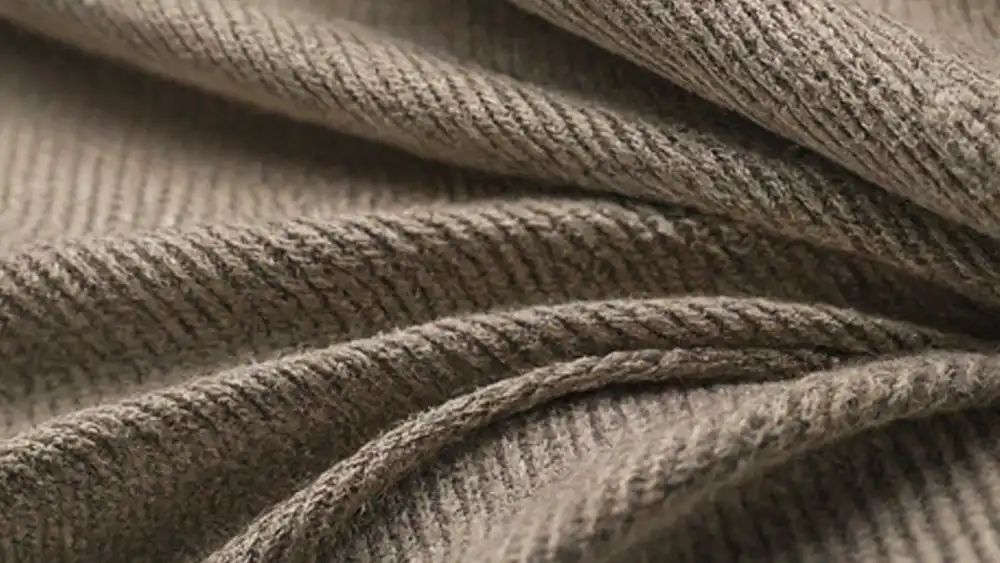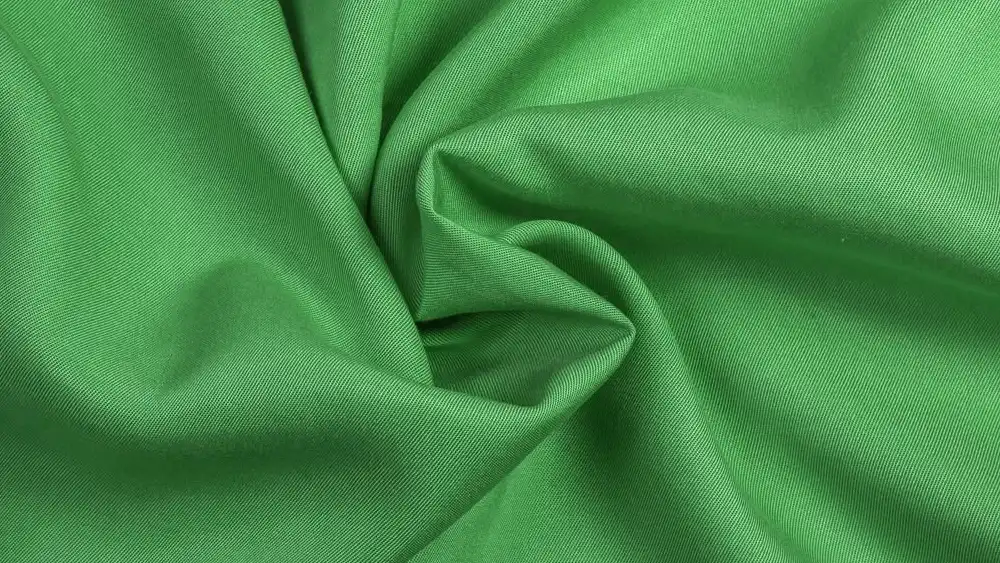Twill fabric is known for its durability and versatility, making it a popular choice for clothing, upholstery, and home decor. However, proper care is essential to preserve its quality and appearance.
In this guide, we’ll explore the best practices and techniques for cleaning twill fabric to ensure it remains pristine for years.
What Is Twill Fabric?

Twill fabric is a type of textile characterized by its distinct diagonal weave pattern. This pattern is created by passing the weft (horizontal threads) over and under multiple warp (vertical threads) threads in a regular progression.
The result is a fabric with a noticeable diagonal rib or line texture. Twill fabrics can vary in weight, texture, and appearance depending on the specific fibers used and the weave density.
They are commonly used in clothing, upholstery, and various other applications due to their durability, versatility, and ability to drape well. Denim, chino, and gabardine are examples of twill fabrics commonly found in clothing.
How to Clean Twill Fabric?

Twill fabric, with its distinctive diagonal weave pattern, is a popular choice for clothing, upholstery, and various other applications due to its durability and versatility. Proper care and cleaning are essential to maintain the quality and appearance of twill fabric over time.
Follow these step-by-step instructions to effectively clean twill fabric while preserving its integrity and longevity.
Step 1: Read the Care Label
Every garment or textile made from twill fabric should come with a care label. This label is your best guide to understanding the manufacturer’s recommended cleaning methods. It will specify whether the fabric can be machine washed, hand washed, dry cleaned, or if there are any specific precautions to take.
Step 2: Spot Test
Before diving into cleaning the entire item, it’s essential to perform a spot test. This involves applying a small amount of the cleaning solution you intend to use on a hidden area of the fabric. Wait for a few minutes to see if any adverse reactions occur, such as color bleeding or fabric damage. If the spot test is successful, proceed with confidence.
Step 3: Pre-Treat Stains
Twill fabric, like any other material, can be prone to stains. Before washing, it’s a good idea to address any visible stains. Use a gentle stain remover or create a solution of mild detergent and water. Apply the solution to the stained area and gently blot with a clean cloth or sponge. Avoid rubbing vigorously, as this can embed the stain further into the fabric.
Step 4: Hand Wash or Machine Wash
Depending on the care label instructions, you’ll either hand wash or machine wash the twill fabric. Hand washing is typically gentler and may be preferred for delicate or special pieces. For machine washing, ensure you use a mild detergent and cold or lukewarm water to avoid shrinking or damaging the fabric.
Step 5: Select Gentle Cycle
If using a washing machine, opt for a gentle cycle. This reduces the risk of excessive agitation, which can cause wear and tear on the fabric. Harsh cycles can also lead to pilling or distortion of the twill weave. Additionally, avoid using bleach or strong detergents that could harm the fabric’s integrity.
Step 6: Avoid Overloading
Proper washing requires enough space for the fabric to move freely within the machine. Overloading the machine can prevent thorough cleaning and rinsing, leading to detergent residue or incomplete stain removal. Follow the machine’s capacity recommendations and allow sufficient room for the twill fabric to agitate without bunching up.
Step 7: Dry Flat or Tumble Dry Low
After washing, remove the twill fabric from the machine promptly. Depending on the care instructions, you’ll either lay it flat to air dry or tumble dry on a low heat setting. Hanging twill fabric to dry can cause stretching or distortion due to the weight of the water, so it’s best to avoid unless otherwise specified.
Step 8: Iron if Needed
If wrinkles are present after drying, you can use an iron to smooth out the fabric. Set the iron to a low to medium heat setting and use a pressing cloth to protect the fabric from direct heat. Avoid high heat, as it can scorch or shine the fabric. Take care not to iron over any remaining stains, as heat can set them permanently.
Step 9: Store Properly
Once the twill fabric is clean and dry, store it appropriately to maintain its condition. Choose a cool, dry area away from direct sunlight to prevent fading or discoloration. Avoid folding or storing the fabric in a cramped space, as this can lead to creases or wrinkles. Instead, hang garments on padded hangers or roll fabric items to minimize creasing.
How to Wash Twill Fabric

To wash twill fabric, follow these steps:
- Read the Care Label: Check the care label attached to the fabric for specific washing instructions.
- Pre-Treat Stains: If there are stains, spot treat them with a gentle stain remover or a mixture of mild detergent and water.
- Select Detergent: Choose a mild detergent suitable for delicate fabrics.
- Prepare Washing Machine: Set the washing machine to a gentle cycle with cold or lukewarm water.
- Load Fabric: Place the twill fabric in the washing machine, ensuring not to overload it.
- Add Detergent: Pour the appropriate amount of mild detergent into the washing machine.
- Wash: Start the washing machine and let it complete the cycle.
- Remove Fabric: Once the cycle is finished, promptly remove the twill fabric from the washing machine.
- Air Dry or Tumble Dry Low: Either lay the fabric flat to air dry or tumble dry it on a low heat setting.
- Iron if Needed: If wrinkles remain after drying, iron the fabric on a low to medium heat setting, using a pressing cloth if necessary.
- Store Properly: Store the fabric in a cool, dry place away from direct sunlight to prevent fading or discoloration.
Following these steps will help you wash your twill fabric effectively while maintaining its quality.
Cotton Twill Fabric Care Tips

Taking care of cotton twill fabric is essential to maintain its appearance and longevity. Here are some tips to help you care for your cotton twill garments:
Washing Instructions:
Machine wash your cotton twill items in cold or lukewarm water to prevent shrinking and color fading.
Use a gentle cycle to avoid stressing the fabric.
If the garment is heavily soiled, pre-treat stains before washing.
Detergent Choice:
Use a mild detergent to clean cotton twill fabric. Harsh detergents can damage the fibers and affect the color.
Avoid bleach as it can weaken the fabric and cause discoloration.
Drying:
Air dry your cotton twill items whenever possible. Hang them on a clothesline or drying rack to preserve their shape and prevent shrinking.
If using a dryer, use a low heat setting to avoid excessive heat exposure.
Ironing:
Cotton twill fabric can wrinkle easily. Iron it while it’s still slightly damp using a medium to high heat setting.
If the fabric is decorated with prints or embroidery, iron it inside out to protect the design.
Storage:
Store cotton twill garments in a cool, dry place away from direct sunlight to prevent fading.
Avoid hanging heavy items on top of them to prevent stretching and distortion.
Avoiding Abrasion:
Cotton twill fabric can be prone to abrasion, so avoid rubbing it against rough surfaces to prevent pilling and wear.
Dry Cleaning:
Some cotton twill items may be labeled as dry clean only. Follow the care instructions provided by the manufacturer to maintain the fabric’s quality.
Regular Maintenance:
Check your cotton twill garments regularly for any signs of damage or wear. Promptly address any issues to prevent further deterioration.
By following these care tips, you can keep your cotton twill fabric looking its best for years to come.
FAQs
Can I bleach twill fabric?
It’s generally not recommended to bleach twill fabric, as bleach can weaken the fibers and cause discoloration. Instead, opt for mild detergent and spot cleaning for best results.
How often should I clean twill fabric?
The frequency of cleaning twill fabric depends on usage and exposure to dirt or stains. As a general rule, regular spot cleaning and occasional laundering or dry cleaning as needed are sufficient.
Can I use fabric softener on twill fabric?
Fabric softeners may leave residue on twill fabric, affecting its texture and appearance. Instead, consider using a small amount of white vinegar in the rinse cycle to soften the fabric naturally.
Is it safe to tumble dry twill fabric?
While twill fabric can often be tumble dried on a low heat setting, air drying is preferable to prevent shrinkage or damage. Check the care label on the item for specific drying instructions.
How can I remove oil stains from twill fabric?
To remove oil stains from twill fabric, apply a small amount of dish soap or laundry detergent to the stained area and gently blot with a clean cloth. Repeat as necessary until the stain is lifted.
Can I dry clean twill fabric?
Yes, twill fabric can typically be dry cleaned for thorough cleaning and stain removal. Follow the instructions provided by the dry cleaner and inform them of any specific concerns or stains.
Conclusion
By following these expert tips and techniques, you can effectively clean and maintain twill fabric items for long-lasting durability and enjoyment. Whether you’re caring for clothing, upholstery, or home decor, proper cleaning methods will ensure that your twill fabric retains its quality and appearance for years to come.
